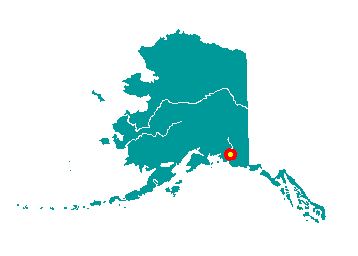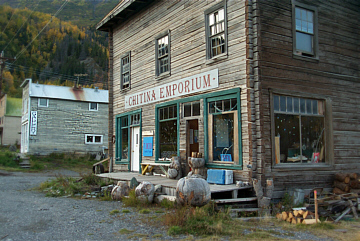|
Chitina
(pronounced CHIT-na)
Chitina is located on the west bank of the Copper River at it confluence with the Chitina River, 66 miles southeast of Glennallen. It lies outside the western boundary of the Wrangell-St. Elias National Park and Preserve.
Chitina is nestled between two of the largest mountain ranges in North America;
the Chugach Range, which stretches along the South Central Coast of Alaska and
the Wrangell Mountains which are home to some of the tallest peaks and largest
glaciers in the world. The community is located in the Chitina Recording District. The area encompasses 29 sq. miles of land and 1 sq. miles of water.
 Athabascan Indians have reportedly occupied this region for the last 5,000 to 7,000 years. Archaeological sites are located to the south and east of Chitina, and for
centuries the Ahtna people had summer fish camps along the river and winter
villages throughout the area. The surrounding
lands were originally home to the Native Athabascan people of the Copper River.
The area of "Tsedi Na" was originally home to several summer fish camps and a
winter gathering area for the first people of Alaska. The town's name is a
mistranslated version of the Athabascan word "Tsedi Na" which means the river
(Na) that flows like copper (Tsedi'). Before
1900, Chitina was the site of large Native village whose population was slowly
decimated by the influx of people, disease and conflicts. Athabascan Indians have reportedly occupied this region for the last 5,000 to 7,000 years. Archaeological sites are located to the south and east of Chitina, and for
centuries the Ahtna people had summer fish camps along the river and winter
villages throughout the area. The surrounding
lands were originally home to the Native Athabascan people of the Copper River.
The area of "Tsedi Na" was originally home to several summer fish camps and a
winter gathering area for the first people of Alaska. The town's name is a
mistranslated version of the Athabascan word "Tsedi Na" which means the river
(Na) that flows like copper (Tsedi'). Before
1900, Chitina was the site of large Native village whose population was slowly
decimated by the influx of people, disease and conflicts.
Rich copper deposits were discovered at the turn of the century along the northern flanks of the Chitina River valley,
bringing a rush of prospectors and homesteaders to the area. Chitina was established as a stop on the Copper River & Northwestern Railway
in 1908. The town became a booming supply
center receiving goods via the railway from the sea port community of
Cordova. Supplies were shipped via the railway on to McCarthy/Kennecott, as well
as onto the interior city of Fairbanks via the overland haul road.
Predictions swirled stating Chitina would be the new capitol of Alaska
circulated in that first part of the 20th century. The town had develop into a thriving
community by 1914 with a general store, an art gallery, clothing store, meat market, stables, a tinsmith, five hotels,
several rooming houses, a pool hall, bars, restaurants, dance halls and a movie theater. Almost all of Chitina was owned by Otto Adrian Nelson, a surveying engineer for
the Kennecott Copper Mines. He built a unique hydroelectric system that supplied
electric power to all his buildings.
 Then
ore prices sharply declined and with that drop the mine closed. The
last train departed Chitina in 1938. Support activities moved to the Glennallen area, and
the once booming community became a virtual ghost town with only the Natives and a few non-Natives staying on. In 1963, the Nelson estate was purchased by "Mudhole" Smith, a pioneer bush pilot, who sold off the townsite and buildings. Much of the land in the area is
now owned by the Chitina Native Corporation. Then
ore prices sharply declined and with that drop the mine closed. The
last train departed Chitina in 1938. Support activities moved to the Glennallen area, and
the once booming community became a virtual ghost town with only the Natives and a few non-Natives staying on. In 1963, the Nelson estate was purchased by "Mudhole" Smith, a pioneer bush pilot, who sold off the townsite and buildings. Much of the land in the area is
now owned by the Chitina Native Corporation.
Chitina lives on with 123
residents (as of the 2000 census)
residing in the town and supporting themselves largely
with salmon from the river, produce from their gardens, berries from the
forests, and the few tourists who stop.
At present the
community consists of a general
store, two small convenience
store/gas stations, three gift shops, three lodging establishments, a post
office, a seasonal National Park visitors cabin, a coffee shop & deli, saloon,
liquor store, fire hall, laundromat with showers, a seasonal burger stand, local state Fish & Game offices and highway
maintenance offices. The town is known for its seasonal salmon runs
of reds, kings and silvers. A summer influx of fishermen, tourists and campers
provides some revenues for fish guiding and other local services.
A federally recognized tribe is located in the community -- the Chitina
Traditional Indian Village. 48.8% of the population are Alaska Native or part
Native. Most residents are involved in subsistence activities year-round.
During the summer, subsistence dipnetting for salmon on the Copper River brings
a large number of Alaskans from Anchorage and other areas of the state.
Gardening, berry picking, herb gathering and other "wild crafting" are popular
pursuits, as are various arts and crafts. Winter activities include trapping,
snow machining, dog mushing, skiing and skijoring, ice fishing.
The climate in Chitina is continental, characterized by long, cold
winters and relatively warm summers with temperature extremes from
-58 degrees F. to +91 degrees F. along the year. Snowfall averages
52 inches, with a total annual precipitation of 12 inches.

Village Corporation - Chitina Native Corporation, P.O.
Box 3, Chitina, AK 99566, Phone 907-823-2223, E-mail:
jhart@ahtna-inc.com
Village Council - Chitina Traditional Village Council, P.O. Box 31,
Chitina, AK 99566, Phone 907-823-2215
|